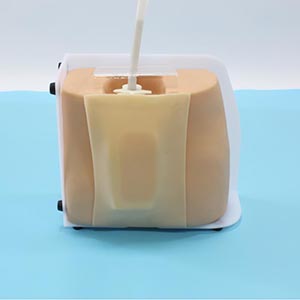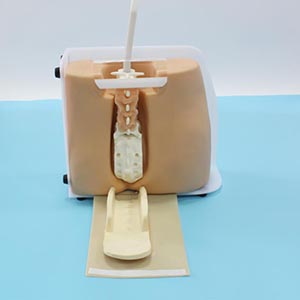Homepageпјҡ NEWS >> Can spinal tap models significantly reduce the failure rate of puncture procedures?
Spinal puncture (also known as lumbar puncture) is a very important and common clinical procedure, widely used in diagnosis and treatment, such as cerebrospinal fluid analysis, anesthesia, etc. For medical students and novice healthcare professionals, mastering this technology is often challenging, especially when faced with complex anatomical structures and clinical situations. Traditional learning methods may have some limitations, it is difficult to provide enough practical opportunities and immediate feedback, resulting in a high failure rate. In recent years, spinal tap model, as a simulation training tool, has gradually become an important part of medical education. This article will explore whether the spinal tap model can significantly reduce the failure rate of puncture procedures and analyze its effects with data support.
The challenge of traditional methods: lack of practical opportunities and high failure rate

Spinal Cord Puncture Model
In traditional spinal tap training, students typically master the technique through lectures, video presentations, and clinical practice on patients. However, these methods have many limitations:
1. Limited opportunities to practice: Because spinal tap is a relatively complex and highly precise procedure, students usually have only limited opportunities to practice in clinical practice. This makes it difficult for students to accumulate enough experience at an early stage.
2. High Risk: For beginners, there are certain risks associated with performing a spinal tap on a real patient, such as failed puncture, pain, or other complications that can cause discomfort or even more serious consequences for the patient.
3. High pressure and easy to make mistakes: When facing real patients, students may operate improperly due to nervousness, resulting in puncture failure or inaccurate puncture, which will affect the treatment effect.
These problems indicate that traditional training methods are unable to meet the needs of students for technical proficiency and confidence, nor can they provide students with sufficient practical opportunities in a safe environment.
Advantages of the spinal tap model: Safe, effective, repetitive practice

The spinal tap model simulates the anatomy of the human spine through a highly simulated design, enabling students to practice repeatedly without causing any harm to the patient. This model has several significant advantages:
1. Degree of imitation, real feedback
The spinal tap model usually uses a detachable simulated spine to simulate the epidural, subarachnoid and other structures of the spine, which can provide a close to real operating experience. Some advanced models are also equipped with a simulated cerebrospinal fluid flow system, so that successful students can observe the corresponding fluid flow, increasing the sense of realism and feedback of the operation.
2. A safe learning environment
The use of models for training can avoid the discomfort and potential risks of patients caused by errors in operation by beginners. Students can practice repeatedly without pressure until they have mastered the correct piercing technique.
3. Real-time feedback and error correction mechanism
Many spinal tap models are equipped with real-time feedback systems that instantly inform participants of the depth, Angle, and success of the puncture. This immediate feedback helps trainees to quickly correct errors in their operations during training, thus improving their technical level.
4. Repeat training to improve proficiency
The model can be used many times, and students can practice a lot in a simulated environment to continuously master the piercing operation skills. Through continuous practice, students can effectively overcome the tension and improve the accuracy and proficiency of the operation.
Data support: Spinal puncture model improves puncture success rate
Multiple studies have shown that students trained using the spinal tap model have significantly improved success rates in practice. Here's some data to back it up:
1. Improved success rate
A study by a medical education institute found that after four hours of spinal tap model training, participants' puncture success rate increased by 30%. In the simulation training, students are able to master the correct Angle, depth and technique of puncture through repeated practice, thus significantly reducing the chance of operation failure.
2. Reduce failure rates
Another clinical study of spinal tap skills training showed a 40% reduction in puncture failure when participants using a spinal tap model performed with real patients. This shows that through effective training of the model, students are able to be more confident in clinical practice, thus reducing operational errors.
3. Reduction of psychological pressure
According to a questionnaire survey, about 70% of students said that after using the model training, they felt significantly less psychological stress when facing real patients. Due to the accumulation of sufficient operational experience in the training, students are more able to calmly cope with complex clinical situations.
Clinical significance: Improve skills and ensure patient safety
The importance of spinal tap models in medical education is not only reflected in the improvement of students' operating skills, but also in the ability to improve patient safety by reducing the rate of operating errors. The following are the clinical implications of several aspects:
1. Improve operation accuracy
By using a spinal tap model, students can practice and master precise puncture techniques over and over again. The improvement of this skill can not only ensure the treatment effect, but also avoid complications caused by improper operation.
2. Ensure patient safety
For healthcare professionals, proficiency in spinal puncture techniques means that they can be more confident in the actual operation, thus reducing the possibility of puncture failure. This directly affects the treatment effect and safety of patients.
3. Develop clinical thinking and coping skills
During the training, participants not only improved their technical skills, but also learned how to deal with challenges in different clinical situations. Through the simulation of the model, students can gradually improve their clinical thinking and ability to cope with complex situations.
Conclusion: The teaching value of spinal puncture model
To sum up, the spinal puncture model has significant advantages in medical education, which can effectively improve students' puncture skills and reduce the rate of surgical failure. By providing a safe, realistic training environment, students are able to practice and master correct piercing techniques over and over without clinical pressure. Data support shows that trainees trained using the spinal tap model have significantly improved puncture success rates and significantly reduced failure rates.
With the gradual development of medical education in the direction of simulation teaching, spinal tap models will continue to be the core tool in medical training, providing students with efficient and accurate skills training, and further improving the quality of clinical practice and patient safety.